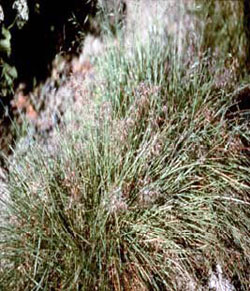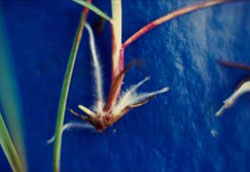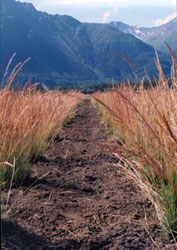| Chapter 5: Cultivars and Species for Use in Alaska Released for Commercial Seed Production Bluegrass, Alpine Teller is a native collection of Poa alpina intended for general revegetation projects throughout Alaska. In the future, this collection may replace ‘Gruening’ alpine bluegrass. The original seed source was near Teller, Alaska – a small village west of Nome, Alaska. This is a Selected Class release (Wright, 2006). 
Figure 49: Teller Germplasm alpine bluegrass
Bluegrass, Arctic Adak Germplasm is a PMC Selected Class Release of the species Poa arctica, arctic bluegrass (Wright, 2006). This collection was, as the name suggests, from Adak Island. The release is unique in the fact that it reproduces via asexual reproduction. This collection is viviparous meaning it produces small plantlets in the seedhead in place of true seed. This collection is adapted to the entire Aleutian Archipelago. It does, however, perform best on dry upland sites in the region. 
Figure 40: Adak Germplasm arctic bluegrass

Figure 41: Viviplets of a viviparous arctic bluegrass plant are shown in this photograph. Note the root development. This root development occurred in less than 24 hours.
Bluegrass, Arctic Council Germplasm arctic bluegrass represents a species that is common throughout Alaska (Wright, 2007). The PMC has released two other germplasm collections of arctic bluegrass; however, both of these were viviparous examples of the species. Council Germplasm produces true seed. This release can be used throughout Alaska on a wide variety of soils, but it will work best in Interior, Western, and Arctic revegetation zones of Alaska. 
Figure 103: Council Germplasm arctic bluegrass
Bluegrass, Arctic Tin City Germplasm arctic bluegrass is another collection of viviparous Poa arctica. This collection, however, was obtained near the small mining town of Tin City, Alaska. The Selected Class release was placed in production in 2006 (Wright, 2006). Tin City Germplasm arctic bluegrass is intended for use in the northern half of Alaska. Like the other viviparous releases, this collection needs to be used as a vegetatively propagated species, not a seeded grass. 
Figure 50: Tin City in production at the PMC

Figure 51: This photograph is of a Tin City viviplet. These reproductive units are smaller than the progeny from the Adak Germplasm release of arctic bluegrass.
Bluegrass, Glaucous Glaucous bluegrass is a relatively common grass on dry mineral soils in the state. This collection was originally harvested near Nome, Alaska. This accession has a wider use range than the bluegrass cultivar ‘Tundra’; however, it is not recommended for use in the arctic revegetation region. Nome was released in 2007 (Wright, 2007). It is also a Selected Class release. 
Figure 107: Nome Germplasm glaucous bluegrass
Bluegrass, Large-glume Large-glume bluegrass is a perennial bunch grass found along coastlines inland of the primary coastal dunes and beach wildrye communities. Andrew Bay Germplasm originated on Adak Island near the mid-point of the Aleutian Island Chain. This variety was collected in 1993 and released for commercial production in 2006 (Wright, 2006). The primary intended use of Andrew Bay Germplasm is revegetation and erosion control in coastal regions of Alaska from the Juneau area westward through the Aleutian Islands, and northward on the Western coast to roughly Scammon Bay. 
Figure 42: Andrew Bay Germplasm large-glume bluegrass
Bluegrass, Big ‘Service’ big bluegrass was a cultivar release in 1989, but the official registration did not occur. The seed has been released and available for commercial exploitation, but no interest in commercial production has arisen to date. The material is currently distributed for experimental purposes and likely has some value in the landscape industry. 
Figure 111: ‘Service’ big bluegrass
|
